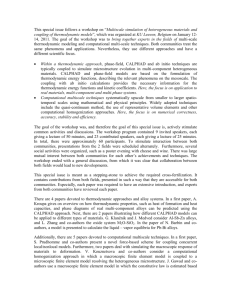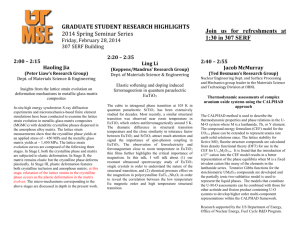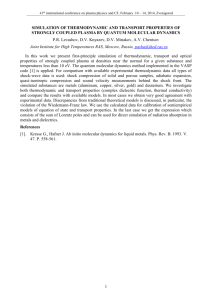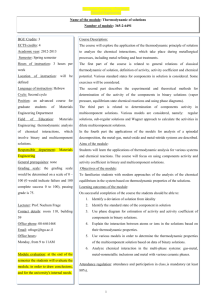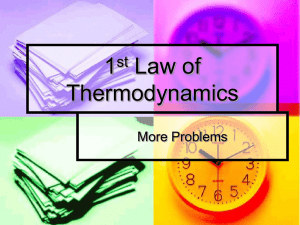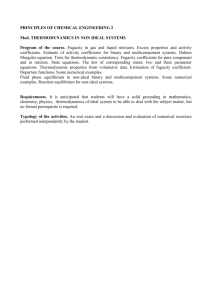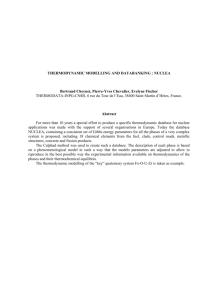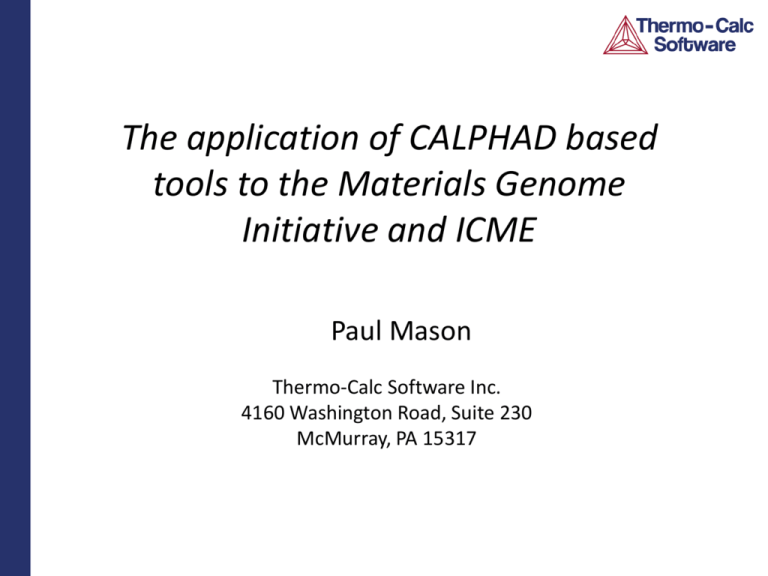
The application of CALPHAD based
tools to the Materials Genome
Initiative and ICME
Paul Mason
Thermo-Calc Software Inc.
4160 Washington Road, Suite 230
McMurray, PA 15317
Goals of this lecture
The 2008 National Academies report on Integrated Computational Materials
Engineering (ICME) and President Obama's announcement of the Materials
Genome Initiative (MGI) in June 2011 highlights the growing interest in using
computational methods to aid materials design and process improvement.
For more than 30 years CALPHAD (CALculation of PHAse Diagrams) based tools
have been used to accelerate alloy design and improve processes. CALPHAD is
based on relating the underlying thermodynamics of a system to predict the
phases that can form and the amounts and compositions of those phases in
multicomponent systems of industrial relevance.
During this lecture, you will:
- Discover how CALPHAD relates to ICME and MGI
- Learn about the underlying concepts of the CALPHAD approach
- See how CALPHAD-based computational tools may be applied in the materials
life cycle for a range of different materials.
Outline
There are three main sections to this lecture:
1. Describing what ICME, MGI and CALPHAD are and how CALPHAD
fits into the larger ICME and MGI framework
2. A more detailed description of CALPHAD, CALPHAD based
software tools and databases that underpin them.
3. Some practical examples of applications to the materials life cycle.
What is ICME?
The National Academies Press, 2008
Integrated Computational Materials
Engineering: A Transformational Discipline for
Improved Competitiveness and National
Security
ICME: an approach to design products, the materials that comprise them, and
their associated materials processing methods by linking materials models at
multiple length scales. Key words are "Integrated", involving integrating
models at multiple length scales, and "Engineering", signifying industrial
utility.
Focus is on the materials, i.e. understanding how processes produce material
structures, how those structures give rise to material properties, and how to
select materials for a given application. This report describes the need for
using multiscale materials modeling to capture the process-structuresproperties-performance of a material.
What is MGI?
June 2011
Materials Genome Initiative for
global competitiveness
The Materials Genome Initiative is a
national initiative to double the
speed and reduce the cost of
discovering, developing, and
deploying new advanced materials.
The influence of chemistry on
microstructure and properties
Chemical Composition
Properties
Microstructure
Processing
Heat treating can best be defined as “the controlled application of time,
temperature and atmosphere to produce a predictable change in the
internal structure (i.e. the microstructure) of a material.” Dan Herring,
100th Column of the “Heat Treat Doctor” published in Industrial Heating
magazine
What should be modeled in the ICME
and MGI?
The analogy of a materials genome to a human genome implies that
something of the nature of the material is encoded in the the chemical
composition of a material and that we should be able to read this.
But nurture is important, as well as nature, and to extend the analogy
further, nurture is the equivalent of processing the material.
In ICME/MGI we are striving to model how the structure and
properties of a material are affected by its composition, synthesis,
processing and usage.
Modelling of structure evolution and kinetic processes thus depends
on what models are available for structure-property relations.
What is CALPHAD?
CALculation of PHAse Diagrams
A phase based approach to modeling the underlying
thermodynamics and phase equilibria of a system
through a self consistent framework that allows
extrapolation to multicomponent systems.
A journal published by Elsevier Ltd.
An international community, and conference held
each year with 150-300 active participants from
around the world.
CALPHAD – a foundation of MGI, ICME and ICMD
Slide courtesy of Prof. G. Olson, Northwestern University, QuesTek Innovations LLC
Requirements for modeling microstructure
evolution
The phases that form and their composition under given conditions (overall composition, temperature and pressure) (Thermo-Calc )
How do these quantities evolve in time? (DICTRA, TC-PRISMA, phase field)
–Synthesis and processing
–Usage
Length scale of microstructure (Phase-field)
Stresses
Details of morphology
Statistics – size distributions etc (TC-PRISMA)
Slide courtesy of Prof. J. Ågren, KTH
CALPHAD – an important bridge to
multicomponent prediction
Towards prediction of microstructure
evolution and material properties
Bridging Atoms and Microstructure
Interfacial energy & Volume & Elastic constants
Thermodynamics: Gibbs energy
Phase Field Method
TC-PRISMA
Langer-Schwartz
CALPHAD
f(
First Principles Calculation
Diffusion: Mobility
The development of consistent databases where each phase is
described separately using models based on physical principles
and parameters assessed from experimental data is a key.
A suite of CALPHAD based software tools
THERMO-CALC
Driving forces
x
Interfacial energies
x
TC-PRISMA
DICTRA
Diffusivities
What is CALPHAD (1)
Thermochemical measurements:
Phase equilibria:
• Enthalpy
• Liquidus
• Entropy
• Solidus
• Heat capacity
• Phase boundary
• Activity
Gibbs Energy of
Individual Phases
Gm f ( x, T , P)
Applications
What is CALPHAD (2)
g’
Thermodynamic
Database
g
R- and m-phase
Thermo-Calc
Description of Gibbs
free energy for the
individual phases
Gm T , P, xi
Minimization of the total
Gibbs free energy under
given conditions.
G N Gm T , P, xi
G
0
xi
Result
Thermodynamic databases
A wide range of thermodynamic databases are available for:
Steels and Fe-alloys
Nickel-base superalloys
Aluminium/Titanium/Magnesium-base alloys
Gases, pure inorganic/organic substances, & general alloys
Slag, metallic liquids, and molten salts
Ceramic systems, and hard materials
Semiconductors, and solder alloys
Noble metal alloys
Materials processing, process metallurgical & environmental aspects
Aqueous solutions, materials corrosion & hydrometallurgical systems
Minerals, and geochemical/environmental processes
Nuclear materials, and nuclear fuel/waste processing
TCNI5 – An example of a multicomponent
CALPHAD database
B
C
Co
Cr
Fe
Hf
Mo
N
Nb
Ni
Pd
Pt
Re
Si
Ta
Ti
V
W
Zr
Al
x
x
x
x
x
x
x
x
x
x
x
x
x
x
x
x
x
x
x
B
x
x
x
x
x
x
x
x
x
x
x
x
x
x
x
x
x
x
C
x
x
x
x
x
x
x
x
x
x
x
x
x
x
x
x
Co
Cr
Fe
x
x
x
x
x
x
x
x
x
x
x
x
x
x
x
x
x
x
x
x
x
x
x
x
x
x
x
x
x
x
x
x
x
x
x
x
x
x
x
x
x
x
x
x
x
Hf
Mo
N
x
x
x
x
x
x
Nb
Ni
Pd
Pt
Re
Si
Ta
Ti
V
W
x
x
x
x
x
x
x
x
x
x
x
x
x
x
x
x
x
x
x
x
x
x
x
x
x
x
x
x
x
x
x
x
x
x
x
x
x
x
x
x
x
x
x
x
x
x
x
x
x
x
x
x
x
x
x
x
x
x
x
x
x
x
x
x
x
x
x
x
x
x
x
x
x
x
x
x
x
x
x
x
20 + 3 elements.
184 of 190 binary systems assessed for full range composition
Total number of possible ternaries (1140)
All Ni containing ternaries plus other ternary systems also
assessed to full range of composition (184 / 1140 in total)
292 intermetallic and solution phases
CALPHAD based software: Thermo-Calc (1)
Calculating stable and meta-stable heterogeneous
phase equilibrium
Amount and composition of phases
Transformation temperatures, e.g. liquidus and
solidus temperature
Predicting driving forces for phase transformations
Phase diagrams (binary, ternary, isothermal,
isoplethal, etc.)
Molar volume, density and thermal expansion
Scheil-Gulliver (non-equilibrium) solidification
simulations
Thermochemical data such as;
– enthalpies
– heat capacity,
– activities, etc.
Thermodynamic properties of chemical reactions
And much, much more….
Designing and
optimization
of alloys
Design and
optimization
of processes
Overview of Thermo-Calc 4.1
Console Mode
Graphical Mode
GUI layout
1.
2.
3.
4.
5.
Project window – shows relations between defined activities
Configuration window – for configuring the selected activity
Results window – graphic and text output
Scheduler window – shows performed and scheduled calculations
Event log window – text output of progress
Getting started
”Quick Start”
Step-by-step instructions for common tasks
”Templates”
Sets up the framework for certain specific tasks
GUI layout
Set-up
Configure
Work flow
Results
CALPHAD based software: Thermo-Calc (2)
Single Pt Eqm
MAP
STEP
SCHEIL
General work flow
Select database
Define the thermodynamic system
Set equilibrium conditions
View results
Single point equilibrium
Use the ”Quick Start”
Calculate the equilibrium state for a steel under the following conditions:
22 Cr 5.5 Ni 3 Mo 0.14 N (bal. Fe) [mass-%] at 1000C
A system size of 1 mole and atmospheric pressure is assumed
Single point equilibrium
Single point equilibrium
”activities”
Single point equilibrium
Early example using thermodynamic calcs
in alloy design
• The first systematic use of of Calphad computational tools and
databases for industrial purposes. Based only on equilibrium
calculations.
• In 1983 Swedish steel producer Sandvik developed a new
generation of duplex stainless steels.
–Same price level as the conventional 18/8 steel
–Twice the strength
–Better corrosion resistance
–Reduced experimental costs (2 instead of 10 years)
• Most important to have 50/50 mixture of FCC-BCC.
• Avoid TCP (e.g. sigma phase)
• Same PRE-number in both phases. PRE (Pitting Resistance
Equivalent) calculated empirically from phase composition.
Slide courtesy of Prof. J. Ågren, KTH
CALPHAD based software: DICTRA
• A general software package for simulation of DIffusion Controlled
TRAnsformations in multi component alloys.
• The result of more than 20 years and 60 man-years R&D at:
Royal Institute of Technology (KTH) in Stockholm, Sweden Max-Planck
Institute für Eisenforschung in Düsseldorf, Germany
Example: Interdiffusion in compound
Helander et al., ISIJ Int. 37(1997), pp. 1139-45
Emphasis has been placed on
linking fundamental methods
to critically assessed
thermodynamic and kinetic
data, allowing simulations
and predictions to be
performed with realistic
conditions on alloys of
practical importance.
CALPHAD based software: DICTRA (2)
All simulations depend on assessed kinetic and thermodynamic
data.
Solve Diffusion
c
c
J where J D
z
t
z
Diffusivities
Boundary conditions
(External or Internal)
2 G
D ~M 2
c
n
kj
Mobilities
Kinetic
2G
c 2
DATABASES
Gibbs Energy
Thermodynamic
A numerical finite difference scheme is used for solving a system
of coupled parabolic partial differential equations.
Diffusion rates are needed
• Modelling must apply in multicomponent systems because the
real alloys are multicomponent. Many diffusion coefficients!
• Various type of coupling effects may make it more complicated
than Fick’s law.
• Details of geometry not of primary importance.
• An approach in the Calphad spirit was suggested for information
on diffusion kinetics (Andersson-Ågren 1992)
– Allowed systematic representatation of the kinetic
behaviour of multicomponent alloy systems.
• DICTRA was developed in the 1990s for numerical solution of
multicomponent diffusion problems in simple geomtries.
Slide courtesy of Prof. J. Ågren, KTH
Available Kinetic Databases
Mobility databases are currently available for:
Steels and Fe-alloys
Nickel-base superalloys
Aluminium alloys
Titanium alloys
-12
10
Minamimo et al.
1423 K
1473 K
1523 K
1573 K
1623 K
-13
10
1623K
Symbols are
experimental data
taken from Minamino
et al. Science and
technology of
advanced materials
2000;1:237-249.
D* (B2,Pt)
1573K
1523K
-14
10
1473K
1423K
-11.5
1573
1523
1473
1423
1373
1323
1273
-12.5
-16
DICTRA
(2006-05-09:20.57.50) :
10
0.43 TIME
0.44 0.45
0.46 0.47 0.48 0.49
= 3600000
0.50 0.51 0.52 0.53
Mole fraction Al
-13.0
0.20
Al
Co
Cr
Fe
Mo
Nb
Ti
0.18
-13.5
0.16
-14.0
0.14
-14.5
-15.0
0
0.05
0.10
0.15
0.20
Mole-Fraction Al
Mass Fraction
LOGDC(FCC,AL,AL,NI)
-12.0
-15
10
0.12
0.10
0.08
0.06
0.04
Symbols are experimental data taken
from Yamamoto et al, Trans. Jpn. Inst.
Met. 21(1980), p. 601.
0.02
0
-1200
-800
-400
0
400
Distance (mm)
800
1200
Symbols are
experimental
data taken from
Campbell et al,
Materials Sci &
Eng A 407(2005),
pp. 135-146.
Example of thermodynamics + diffusion - Nitriding
– Nitride formation at steel surface during nitriding of steel:
(Du et al. 1996, 1998)
– A surface modification process with many advantages. How thick
are the surface layers?
CALPHAD based software: TC-PRISMA (1)
Concurrent nucleation, growth/dissolution, coarsening
using a mean field approach.
• Particle Size Distribution
THERMO-CALC
Xi & T(t)
DICTRA
T
C
P
R
I
S
M
A
• Number Density
• Average Particle Radius
• Volume Fraction
• TTT/CCT
• Average Compositions
• Interface Compositions
• Nucleation Rate
• Critical Radius
The need for interfacial energies
The length scale is typically determined by a combination of
thermodynamic driving forces, interfacial energy, diffusion and
the dynamic nature of the process.
Modelling and databases for interfacial energy needed.
In the simplest case interfacial energy is just a number (which
may be difficult to determine experimentally but could be
obtained from e.g. coarsening studies). Because of uncertainty
could be treated as a calibration factor.
CALPHAD based software: TC-PRISMA (2)
Classic Nucleation Theory
Grain size, dislocation density, etc
*
G
*
J s Z N exp
kT
J t J S exp
t
Interfacial energy Volume
1/ 2
1 Gn
Z
2
2kT n n*
2
/
*2 n
X
X
4
r
i
*
4
/
X
Di
a i 1
i
3 2
16
Vm
*
G
2
3Gm
/ 2
i
1
1
2 *
2Z
TC-PRISMA Examples: Ni-based superalloy (1)
Booth-Morrison et al. Acta Mater. 56(2008) 3422-3438
Sudbrack et al. Acta Mater. 56(2008)448-463
Sudbrack et al. Acta Mater. 54(2006)3199-3210
Ni-9.8Al-8.3Cr
Ni-9.7Al-8.5Cr-2W
Ni-7.5Al-8.5Cr
Ni-5.2Al-14.2Cr
g’
g’
g’
s = 0.023 J/m2
Thermo-Calc and Dictra
Databases
1273 K
1363 K
1573 K
1173 K
20 hr
0.5 hr
24 hr
3 hr
Mao et al, Nature materials, 6(2007)210-216
(~90 K + Solvus)
1073 K, 873 K
~ 264 hr, ~ 1024 hr
TC-PRISMA Examples: Ni-based superalloy (2) –
Mean radius
TC-PRISMA Examples: Ni-based superalloy (3) –
Number density
TC-PRISMA Examples: Ni-based superalloy (4) –
Rene88DT
Change only system and use same set of physical parameters
TC-PRISMA Examples: Particle size distribution
CALPHAD based software: Phase field (1)
• Output:
– Detailed morphology
– Concentration fields
– Stress fields
– Plastic strain fields (dislocation density fields)
– ...
• Need or can use input from
– Multicomponent thermodynamics
– Multicomponent diffusion analysis
– Interfacial energy and mobility
– Elastic coefficients and stresses
– Stress-free transformation strain tensor (eigen strains)
– Plastic relaxation
– Fluid flow (Navier Stokes)
– ....
Slide courtesy of Prof. J. Ågren, KTH
CALPHAD based software: Phase field (2)
Slide courtesy of Dr. Georg J. Schmitz, ACCESS
Mobility
Database
The underlying principles
Of CALPHAD and
Thermo-Calc
Thermodynamics
ISBN 978-0-521-85351-4
Assessment guide
ISBN 978-0-521-86811
Behind Thermo-Calc
Thermodynamic Databases (The CALPHAD approach)
Thermochemical
measurements:
Phase equilibria:
• Liquidus
• Enthalpy
• Solidus
• Entropy
• Phase boundary
• Heat capacity
• Activity
Gibbs Energy of
Individual Phases
Gm f ( x, T , P)
Applications
CALPHAD Methodology
Empirical
Rules
Ab Initio Calculation
Models
Gm T , P, xi
Experimental
Data
Parameter
Optimization
Database
Thermodynamic Properties
Equilibrium States
Phase Diagrams
Experimental Determination
Fundamental
Theory
Thermodynamic Modeling
Reference state
Pure elements/substances
Gm H mSER a bT cT ln( T ) diT i
Gibbs energy relative to a standard element reference state
(SER), i.e. the enthalpy of the element in its stable state at
298.15K and 0.1MPa. GHSERFE means the Gibbs energy of
FE under SER state.
Entropy at 0K = 0 (+TS(0))
Needed because there is no absolute value of the enthalpy of a
system and one must select some reference state.
For a reference state, one can change its phase structure,
temperature, and pressure.
Thermodynamic Modeling
Gibbs energy per mole for a solution phase is normally divided in:
0
Gm Gm
ideal
Gm
reference surface
xs
Gm
excess term
configurational contribution
•
•
•
Ideal solution model
Regular solution model
Real solution
ph
Gm
physical contribution
Binary - Ideal Solution Model
For a A-B binary solution phase: (A,B)
Gm Gm0 Gmideal
Gm0 x AGAo xBGBo
Gmideal RT x A ln x A xB ln xB
Binary - Regular solution model
Gm Gm0 Gmideal Gmxs
G x AG xBG
0
m
o
A
o
B
Gmideal RT x A ln x A xB ln xB
Gmxs xA xB 0 LA, B
0
LA,B a bT
S mxs x A xB b
H mxs x A xB a
C Pxs 0
G
o
A
G
0
m
Gmxs
Gmideal
G
GBo
Binary - Real solutions
Gm Gm0 Gmideal Gmxs
G x AG xBG
0
m
o
A
o
B
Gmideal RT x A ln x A xB ln xB
Redlich-Kister Expansion
G x A xB LA,B ( x A xB )
xs
m
k
k 0
k
xA xB 0 LA,B 1LA,B ( xA xB ) 2LA,B ( xA xB )2 ....
Ternary solutions
Gm G G
0
m
ideal
m
G
xs
m
Gm0 x AG Ao xB GBo xC GCo
Gmideal RT x A ln x A xB ln xB xC ln xC
Gmxs xi x j I ij xi x j xk I ijk ....
i
j i
i
From
Binary
j i k j
From
Ternary
Thermodynamic models
Thermodynamic models handle EOS & all kinds of thermodynamic properties
for various systems. Some of the available models are:
Component-Energy Model (interaction on up to ten sublattices):
• Redlich-Kister polynomials (Muggianu or Kohler extrapolation)
• Stoichiometric constraints
• Interstitial solution
• Chemical ordering
• Ionic constituents
Two-Sublattice Ionic Liquid Model
Associated Model
Quasi-chemical Model
Kapoor-Frohberg Cell Model
Inden Model for magnetic ordering
CVM (Cluster Variation Methods) for chemical ordering
Birch-Murnagham Model (pressure-dependency) for minerals/alloys
SUPERFLUID Model for C-H-O-S-N-Ar fluid & gaseous mixtures
DHLL, SIT, HKF and PITZ Models for aqueous solutions
Flory-Huggins Model for polymers
Compound Energy Formalism
(CEF)
The sublattice model has been used extensively to describe
interstitial solutions, carbides, oxides, intermetallic phases etc.
It is often called the compound energy formalism (CEF) as one
of its features is the assumption that the compound energies are
independent of composition. It includes several models as
special cases.
Note that the Gm for sublattice phases is usually expressed in
moles for formula units, not moles of atoms as vacancies may be
constituents.
Simple Binary Example of CEF
nhcp
Gmhcp xCo GCo
x Ni 0GNinhcp RT ( xCo ln xCo x Ni ln x Ni )
0
exGmnhcp magGmhcp ,
where
0
ph
Gelem
a bT cT ln T dT 1 eT 2 fT 2 ...
j
ex
Gmnhcp xCo x Ni ( xCo x Ni ) i i Lhcp
Co , Ni
i 0
i
Lhcp
Co , Ni A BT
mag
Gmhcp an expression of similar form as Gmhcp
Simple Binary Example of CEF
PARAMETER G(HCP_A3,CO:VA;0) 298.15 +GHSERCO;,,N !
PARAMETER G(HCP_A3,NI:VA;0) 298.15 +GHCPNI;,,N !
FUNCTION GHSERCO
298.15 +310.241+133.36601*T
-25.0861*T*LN(T)-.002654739*T**2-1.7348E-07*T**3
+72527*T**(-1) 1768.0 Y -17197.666+253.28374*T
-40.5*T*LN(T)+9.3488E+30*T**(-9);,,
N !
FUNCTION GHSERNI
298.15 -5179.159+117.854*T
-22.096*T*LN(T)-.0048407*T**2;
1728.0 Y -27840.655+279.135*T-43.1*T*LN(T)
+1.12754E+31*T**(-9);,, N
!
PARAMETER L(HCP_A3,CO,NI:VA;0) 298.15 -1620-.385*T;,,N !
PARAMETER TC(HCP_A3,CO:VA;0) 298.15 +1396;,,N !
PARAMETER BMAGN(HCP_A3,CO:VA;0) 298.15 1.35;,,N !
PARAMETER TC(HCP_A3,NI:VA;0) 298.15 633;,,N !
PARAMETER BMAGN(HCP_A3,NI:VA;0) 298.15 .52;,,N !
PARAMETER TC(HCP_A3,CO,NI:VA;0) 298.15 411;,,N !
PARAMETER TC(HCP_A3,CO,NI:VA;1) 298.15 -99;,,N!
PARAMETER BMAGN(HCP_A3,CO,NI:VA;0) 298.15 1.046;,,N !
PARAMETER BMAGN(HCP_A3,CO,NI:VA;1) 298.15 .165;,,N !
Simple Binary Example of CEF
G of hcp in Co-Ni
Co
Ni
Fe-Cr at 750 K: Gibbs Energy
Thermodynamic Databases
Databases are produced by critical assessment of experimental
data and optimization of model parameters (the CALPHAD
method).
PARROT in Thermo-Calc Classic can be used as a tool in this
process.
Description of the Gibbs energy for each phase
G=G(x,T,P) is stored in the database
The CALPHAD method.
CALPHAD Method
Thermochemical data
Calorimetric data – Enthalpy of formation, Enthalpy of
mixing, Enthalpy of transformation
EMF, Knudsen cell data – Chemical potentials, Activities
Partial pressure – Activities
DSC – Heat content, Heat capacity, Enthalpy of
transformation
CALPHAD Method
Phase diagram data
Thermal analysis – Start and end temperatures of
transformation
Microscope – Identification of phases, amount of phases
X-ray – Phase identification, lattice parameters
Microprobe – Phase identification, composition of phases
X-ray and neutron diffraction – site occupancy
Sources of thermodynamic data
Two types of data
Basic thermodynamic and phase equilibrium data – the
building blocks of thermodynamic databases
Experimental
Phase equilibrium (phase diagrams) for binary and ternary
system (liquidus/solidus/phase boundary)
Thermodynamic data for compounds/stoichiometric phases
Activity measurements etc
Theoretical
Estimation and Ab initio calculations
Higher order (multi-component data) – validation for alloys
etc
Experimental
Cp, liquidus/solidus/phase boundary data etc for “real” alloys
Volume fraction of carbides etc
Binary and ternary systems
Normally collected from the literature
Reliable data is selected and critically assessed
Hm(Liquid)
Both phase diagram data or thermodynamic data (H,Cp...) can
be used
Higher order systems: Real alloys for validation
From: Saunders & Miedownik: ”Calphad -a comprehensive review”
Density and Lattice parameter
Lattice parameter of Ni-base alloy
3.68
3.66
Inconel 82 (Ni72-20Cr-3Mn-2.5Nb-1.0Fe-0.55Ti-0.2Si)
Inconel 600 (Ni72-15.5Cr-8Fe-1.0Mn-0.5Cu-0.5Si)
Inconel 625 (Ni61-21.7Cr-3.9Fe-8.8Mo-3.9Nb-0.23Ti-0.15Si)
Inconel 718 (Ni52.52-18.34Cr-5.10Nb-3.07Mo-1.0Ti-0.5Al)
Steel D9
Fe-20.5Cr-19.5Ni-19.4Mn-20.4Co, at%
+1%
3.64
3.62
3.60
-1%
3.58
3.56
Density of steels
3.54
3.52
3.50
3.50
8400
3.70
3.65
3.60
3.55
Experimental lattice parameter
Calculated density (kg/m3)
Calculated lattice parameter
3.70
Austenitic stainless steel
High alloy austenitic steel
Ni-base alloy
High Cr and Ni
Duplex
Ferritic stainless steel
HSLA or carbon steel
Stainless steel alloyed by Al
8200
8000
7800
7600
+1%
7400
-1%
7200
7000
6800
6800
7200
7600
8000
8400
Experimental density (kg/m3)
Density of Carbon Steel
0.11 wt% C, 0.1 wt% Si, 0.48 wt% Mn, 0.02 wt% P
7800
7700
Density (Kg/m3)
7600
fcc+MnS
7500
7400
7300
fcc
7200
7100
7000
02Mizukami
6900
6800
1000
liquid
1200 1400 1600 1800
TEMPERATURE_KELVIN
2000
Examples of applications
related to
the materials life cycle
Examples with application to the materials
life cycle
Example: Influence of alloy composition (1)
Example provided by Alojz Kajinic, Crucible Research (ATI Powder).
temperature = 2100°F
V + Nb = constant = 5.27 at. %
X235 HTM
(Fe-C-20Cr-1Mo-V-Nb)
Example: Influence of alloy composition (2)
M7C3+MC
M7C3
temperature = 2100°F
V + Nb = constant = 5.27 at. %
MC
Fe-C-20Cr-1Mo-V-Nb
Example: Optimization of an alloy
composition
Franck Tancret – Université de Nantes (TMS 2009):
Optimization of an alloy composition for the design of weldable and creep
resistant superalloys using Matlab, TC-Matlab toolbox and neural net models.
Over 16,000 compositions assessed.
Example: Forging and hot rolling
Selecting optimum temperature
for operation.
Fraction of phase
Safe forging of supermartensitic stainless
in g-field
C 0,02%
Cr 12%
Ni 5%
Mo 2%
Mn, Si
Ti, N,
Temperature [C]
Courtesy André Costa e Silva
Example: Homogenizing a Ni based
superalloy (1)
Homogenizing a Nickel based superalloy: Thermodynamic and
kinetic simulation and experimental results.
Paul D Jablonski and Christopher J Cowen (NETL, Albany, OR)
Met. Trans. B. Vol 40B, April 2009 (pp 182-186)
Example: Homogenizing a Ni based
superalloy (2)
Thermodynamic data from the Thermotech Ni-data database
Mobility data from the MOBNi1 database.
Scheil calculation
used to predict the fraction
solid curve and incipient
melting temp -1142C.
and extent of chemical
microsegregation - amounts of
each alloying element in the FCC
(g) phase
MC carbide forms
Carbides MC & M6C lose stability
Example: Homogenizing a Ni based
superalloy (3)
Example: Homogenizing a Ni based
superalloy (4)
DICTRA simulations performed to simulate homogenization.
Assumptions: Diffusion distance of 50 mm based on approx one half of the maximum secondary
dendrite arm spacing. Weight fraction of FCC scaled to this distance and read into DICTRA along
with the chemistry profiles across the FCC dendrites from the Scheil simulations.
First heat treatment simulated at 1100C (below incipient melting temp).
But incipient melting temp changes with chemical profile. In second case calculated a new incipient
melting temp after 10,000 secs of 1275C.
Significant improvement of the alloy homogeneity was predicted even after only 8.33 hrs (30,000 secs)
@1200C after the initial 10,000 secs @ 1100C.
Example: Heat Treatment
Applications to a wide range of heat treatment related
simulations, e.g. to calculate:
Gas phase reactions
Equilibrium between alloy and gas phase as a function
of temperature and composition
Predict formation of phases / volume-fractions etc.
Oxide scale formation
THERMO-CALC (2006.09.15:17.53) :
Decomposition
of Acetylene
10temperatures
mbar
Decomposition of Acetylene
at 10 mbar and at
various
Carbide dissolution
10
C2H2
1
Graphite suspended
.1
.01
H2
.001
-4
C2H4
10
aC>1.0
C5
-5
CH4
10
C2H3
-6
10
-7
10
C3
H
-8
H
C2
H
C 3
10
400
500
600
700
800
Temperature (oC)
900
1000
2006-09-15 17:58:52.13 output by user pingfang from PIFF
Partial Pressure of Important Gasoues Species (mbar)
100
Example: Calculated Lehrer diagram
© 2011 Center for Heat Treating Excellence, Worcester Polytechnic Institute,
Worcester MA, all rights reserved
Example: Carburization of highly alloyed
steels (1)
•Use of activity-flux function in
DICTRA (2006-05-21:16.34.57) :
TIME
= 1800,3600,14400
order to
account
for “surface
reaction”.
CE
0.9
where f is a mass-transfer
coefficient that needs to be
determined for each case.
0.8
AISI 1018 steel
carburized at 899 ºC
0.7
WEIGHT-PERCENT
C C
Mass-Percent
Jc = f (acgas – acsurf)
0.6
f = 9.1 • 10-9 [m/s]
acgas = 0.67
0.5
The “surface-reaction” taking
place at the steel surface (and
the mass-transfer coefficient) is
believed to be strongly affected
by pressure.
0.4
0.3
0.2
1h
4h
30 min
0.1
0.0 0.2 0.4 0.6 0.8 1.0 1.2 1.4 1.6 1.8 2.0
DistanceDISTANCE
from surface [mm]
Example: Fe-13Cr-5Co-3Ni-2Mo-0.07C (I)
An example involving a complex alloy where alloying
DICTRA
(2006-05-22:04.55.31)
:
DICTRA (2006-05-22:05.09.17)
:
elements
will
tend
to
form
carbides
at
high
C-activities.
TIME = 1800,9000
TIME = 9000
CELL #1
0.40
0.35
3.5
Jc = 9.1 •
3.0
10-9
(0.9 – ac
0.30
surf)
0.25
2.5
0.15
1.5
0
0.0
0.10
2.5h
1.0
0.5
after 2.5h
M 7 C3
0.20
2.0
0.2
cem
M23C6
0.05
0.5h
0.4
0.6
DISTANCE
0.8
1.0
Distance from surface [mm]
0
0.0
2006-05-22 04:55:31.57 output by user anders from NEMO
1750 ºF (955 ºC)
4.0
TABLEof
FOO
carbide
Fraction
WEIGHT-PERCENT C
Mass-Percent of C
4.5
C
0.2
0.4
0.6
DISTANCE
0.8
1.0
Distance from surface [mm]
Example: Fe-13Cr-5Co-3Ni-2Mo-0.07C (2)
(2006-05-22:05.16.35)
:
• Adding a DICTRA
1.5hTIME
“diffusion
step”.
= 9000,16200
CELL #1
4.5
WEIGHT-PERCENT C
Mass-Percent of C
4.0
3.5
3.0
2.5h
2.5
2.0
1.5
2.5h + 1.5h
1.0
0.5
0
0.0
0.2
0.4
0.6
DISTANCE
0.8
1.0
Distance from surface [mm]
Example: Fe-13Cr-5Co-3Ni-2Mo-0.07C (3)
DICTRA (2006-05-22:05.16.09)
:
• Cr depletion
in the FCC matrix.
TIME = 9000,16200
CELL #1
0.14
Mass-Percent
W(FCC,CR) of
Cr
0.12
0.10
0.08
2.5h + 1.5h
0.06
0.04
2.5h
0.02
0.0
0.2
0.4
0.6
DISTANCE
0.8
1.0
Distance from surface [mm]
Example: Fe-13Cr-5Co-3Ni-2Mo-0.07C (4)
Validation is important!
Complements experiments, does not replace the need to do them.
Turpin et al., Met. Trans. A 36
(2005), pp. 2751-60
Example: Precipitation kinetics M23C6 in
AISI 316
Input data for simulation:
1000
[97Zah]
Composition
C 0,08%
Cr 18%
Ni 12%
Mo 2%
Mn 1.5%
AISI 316
Mean radius, nm
1073 K
923 K
100
Time & temperture
Nucleation at grainboundaries
@ 650 C
10
• g-grainsize =100 mm
This work
• = 0.3 J/m2
1073 K
923 K
1
.01
.1
1
Time, hr
10
@ 800 C
100
• g-grainsize =1000 mm
• = 0.2 J/m2
Example: Welding and joining
CALPHAD based tools such as Thermo-Calc and DICTRA
with suitable databases can predict:
Liquid-gas equilibrium
Liquid-slag interactions
Formation of inclusions
Liquid-solid interactions
Weld metal solidification paths and temperature ranges
Microsegregation during solidification
Prediction of HAZ grain boundary liquation
Formation of precipitate phases at dissimilar welds
Post weld heat treatment and more….
S. Babu, International Materials Reviews, 2009 Vol. 54 No. 6
Example: Composition control
SAF 2507: Fe – 25% Cr – 7% Ni – 4% Mo – 0.27% N –
0.02% C. Sigma phase is predicted to be stable below
1030 ºC. How is this temperature influenced by
changes in the alloy chemistry?
Variation analysis
Composition range:
Fe
Base
Cr
23 – 27%
Ni
6 – 8%
Mo 3 – 5%
N
0.25 – 0.29%
C
0 – 0.03%
125 = 248832 calculations
Example: Corrosion
• These tools have also been applied to model
different type of corrosion in alloys, e.g.
High-temperature oxidation
Salt corrosion
Aqueous corrosion
THERMO-CALC (2003.02.25:11.33) : Pourbaix Diagram Calculation
16
15
14
1
3
0.3
0
3
8
5
8
0
3
Cor
rosi
on
9
1
1
-1.2
44
8
4
9
2 5
7
10
Pass
49
+ Fe
2 O3
Cr O
2
iv1atio
4
6
1
12
FeCr2O4 + FCC
-0.6
-1.5
1
FeCr
3 2O
FeCr2O4 + Fe113O47
-1.0
-0.9
2
+N
iFe
2O
4
Cr O
2
3
7
Imm1
u8nity
13
-0.5
-0.3
3
3
7
11
Fe
2O
9
FeCr
2 O4 +
Fe O
2
1
FeC 8
r
3
+ NiF
e2 O
+ Fe
2 O3
n
4
14:*MOO2_75
15:*MOO2_875
16:*MOO2_889
17:*MOO3
11:*PYRRHOTITE_FE_877S
7:*PYRITE
12:*NI3S2
13:*NIS
8:*NIS2
5:*MOS2
+ NiF
e2 O
4
F2
8 4
2O
13 41 +
9
e5Cr 2
2O
F7 e O6 4 + Fe3 O
3 4 +6
13
FCC 4 + NiFe O
2
12
4
11
GAS (Reducing)
Steel: Fe- 17.00Cr-12.00Ni-2.5Mo (wt% )
5
11 9
Aqueous Solution: 1 kg of water with 0.537 m H2SO4
12
T=85oC, P=1 bar
00
12
24
3
6
4
8
5
pHpH
106
712
814 9
10
2003-02-25 11:57:41.56 output by user pingfang from VITANI
Eh (V)
Eh (V)
0.6
0.5
6:*MAGNETITE
4:*FECR2O4
GAS (Oxiding)
3:*MOO2
Cr2 O +
Fe2 O
3
3
2003-11-26 12:29:31.64 output by user pingfang from PIFF
2
17
AQUEOUS
THERMO-CALC (2003.11.26): Pourbaix Diagram Calculation
T=358.15
1.5 K, P=1 bar, B(H2O)=1000 g, N(H2SO4)=0.537 m
Pourbaix
DiagramN(Mo)=2.6058E-5,
N(Fe)=1.2266E-3,
N(Cr)=3.2695E-4,
N(Ni)=2.0446E-4
For the heterogenous
interaction
between 0.001 m of Fe-alloy (Fe1.2 9
5Cr-5Ni mole%) and 1 kg of10:*AQUEOUS
water
9:*GAS
(and with 3 m NaCl), at 200oC
and
1:*CR2O3
1.0
17
2:*HEMATITE
100 bar.
0.9
Pourbaix diagram for the heterogeneous interaction
between 0.001 m of steel [Fe-5Cr-5Ni mole%] and 1 kg
of water (and with 3 m NaCl), at 200oC and 100 bar.
Summary
An important part of ICME and the MGI is aimed at improving our ability to
model how processes produce material structures, how those structures
give rise to material properties, and how to select materials for a given
application in order to design and make better materials cheaper and
faster. This requires multiscale materials models to capture the processstructures-properties-performance of a material.
CALPHAD is a phase based approach to modeling the underlying
thermodynamics and phase equilibria of a system through a self consistent
framework that allows extrapolation to multicomponent systems. The
approach has also been extended to consider multicomponent diffusion as
well. CALPHAD provides an important foundation to ICME and the MGI in a
framework that is scalable to multicomponent systems of interest to
industry.
For more than 20 years CALPHAD based tools have been used to
accelerate alloy design and improve processes with applications
throughout the materials life cycle.
Questions?

